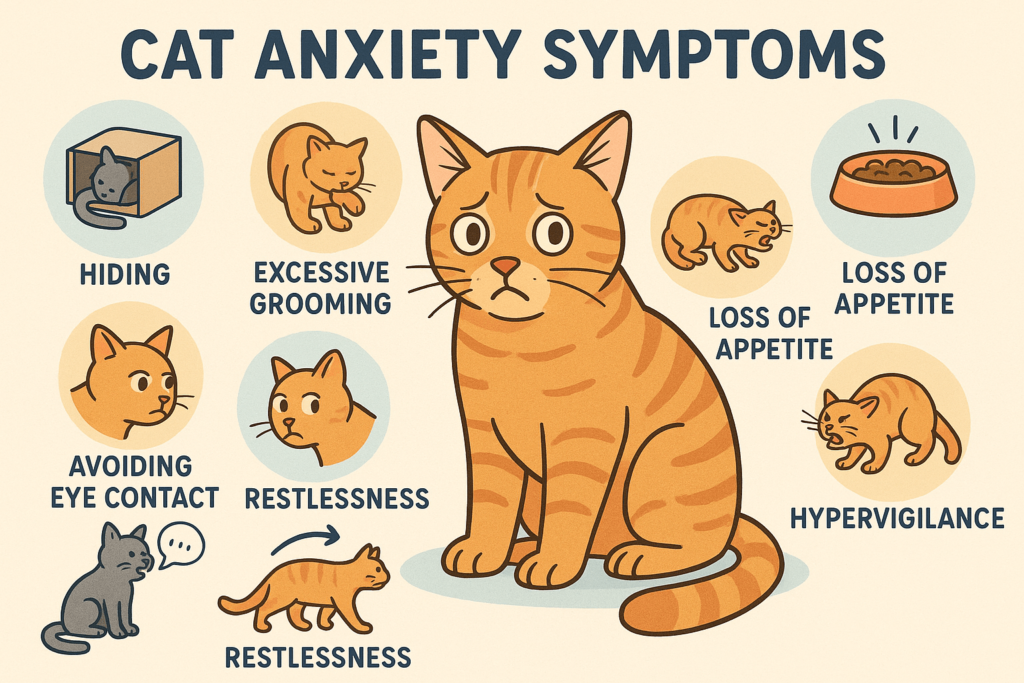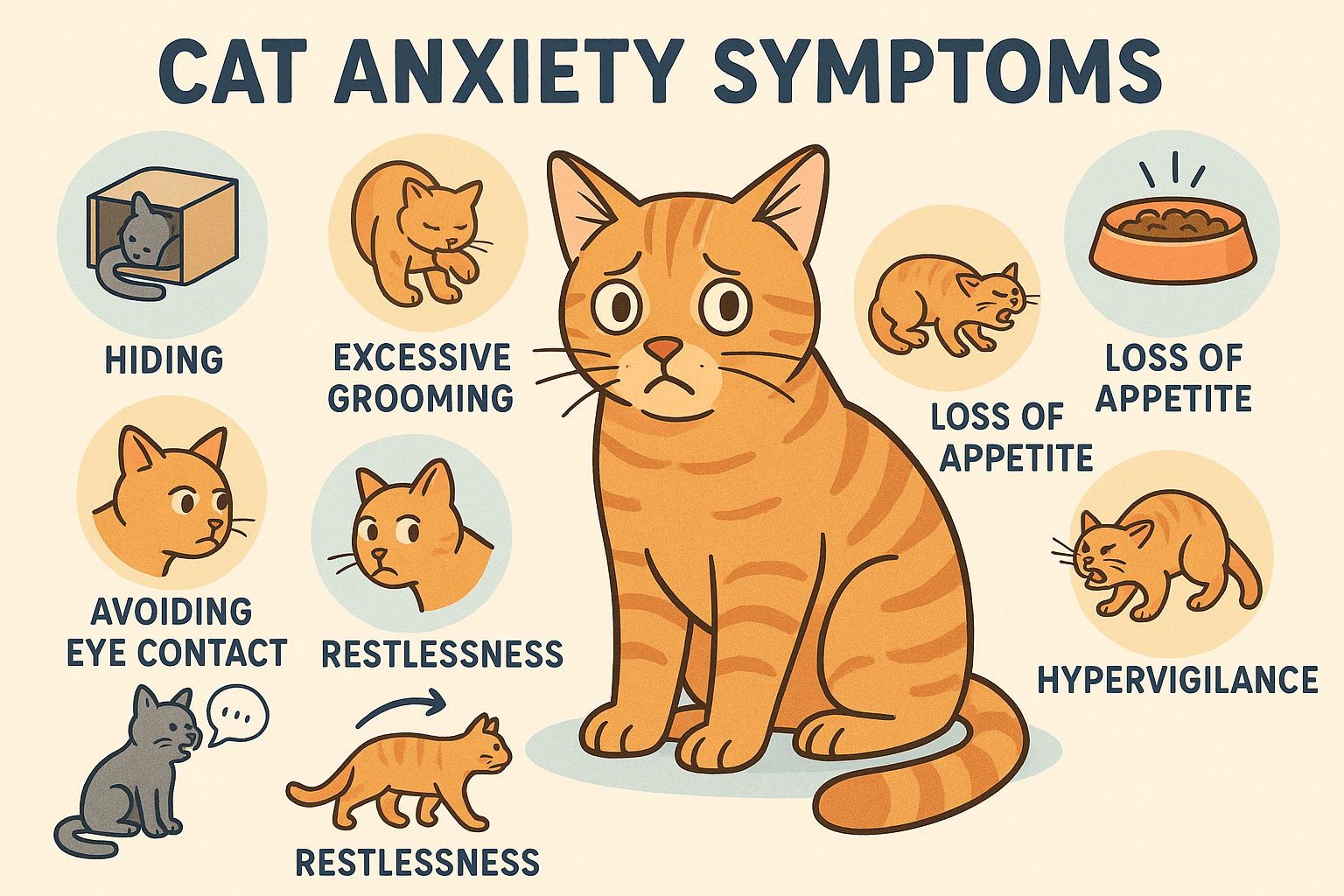Cat Anxiety Symptoms: Understanding and Addressing Feline Stress
Cats are often seen as independent and self-sufficient creatures, but they can experience anxiety just like humans and other animals. Cat anxiety symptoms may manifest in subtle or obvious ways, and recognizing these signs is crucial for ensuring your feline friend’s well-being. Whether triggered by changes in their environment, health issues, or past trauma, anxiety can significantly impact a cat’s quality of life. In this blog post, we’ll explore common symptoms of cat anxiety, discuss potential causes, and provide practical tips for helping your furry companion feel safe and secure. By understanding and addressing your cat’s emotional needs, you can strengthen your bond and create a happier home for everyone.
Common Symptoms of Cat Anxiety
Cats communicate their feelings through behavior, and anxiety often shows up in ways that might initially seem unrelated to stress. Here are some key symptoms to watch for if you suspect your cat may be experiencing anxiety.
Excessive Grooming:
Over-grooming can lead to bald patches or irritated skin, as cats use grooming as a coping mechanism when feeling stressed.Hiding or Avoidance:
An anxious cat may spend more time hiding under furniture, in closets, or in other secluded areas to escape perceived threats.Aggression Toward People or Pets:
Sudden acts of aggression, such as hissing, swatting, or biting, can indicate underlying anxiety or fear.Changes in Appetite:
Some cats eat less when anxious, while others may overeat as a form of comfort-seeking behavior.Vocalization Changes:
Increased meowing, yowling, or unusual sounds may signal distress or attempts to communicate discomfort.
By observing these behaviors, you can identify potential signs of anxiety early and take steps to address them before they escalate.

Physical Signs of Cat Anxiety
In addition to behavioral changes, anxiety can also affect a cat’s physical health. These symptoms may overlap with medical conditions, so it’s important to consult a veterinarian if you notice any of the following.
Digestive Issues:
Anxiety can lead to vomiting, diarrhea, or constipation due to stress impacting the digestive system.Panting or Rapid Breathing:
Unlike dogs, cats rarely pant unless they’re extremely stressed or overheated.Excessive Shedding:
Stress can cause sudden shedding, even in small amounts, which may leave clumps of fur around your home.Dilated Pupils:
Wide, dilated pupils often accompany heightened anxiety or fear in cats.Trembling or Shaking:
Cats may tremble when they’re scared or overwhelmed, similar to how humans react to intense stress.
Recognizing these physical symptoms helps you differentiate between normal behavior and signs of anxiety-related distress.
Behavioral Symptoms | Physical Symptoms |
|---|---|
Excessive grooming | Digestive issues (vomiting, diarrhea) |
Hiding or avoidance | Panting or rapid breathing |
Aggression toward people or pets | Excessive shedding |
Changes in appetite | Dilated pupils |
Increased vocalization | Trembling or shaking |
Causes of Cat Anxiety
Understanding what triggers anxiety in cats is essential for addressing the root cause of their distress. While every cat is unique, certain factors commonly contribute to feline anxiety.
Environmental Changes:
Moving homes, rearranging furniture, or introducing new pets can disrupt a cat’s sense of security.Loud Noises:
Thunderstorms, fireworks, or construction noise can overwhelm sensitive cats and trigger anxiety.Health Problems:
Pain, illness, or chronic conditions may cause stress and anxiety in cats who cannot express their discomfort verbally.Past Trauma:
Cats adopted from shelters or rescued from abusive situations may carry emotional scars that contribute to ongoing anxiety.Separation from Owners:
Cats form strong bonds with their humans, and prolonged absences can lead to separation anxiety.
Identifying the source of your cat’s anxiety allows you to implement targeted solutions that restore their peace of mind.
Ways to Help Your Anxious Cat
If your cat is showing signs of anxiety, there are several strategies you can try to help them feel calmer and more secure. These approaches focus on creating a supportive environment and addressing specific triggers.
Provide Safe Spaces:
Set up cozy hiding spots where your cat can retreat when feeling overwhelmed.Use Pheromone Diffusers:
Products like Feliway mimic calming pheromones and can reduce stress in anxious cats.Establish a Routine:
Consistent feeding, playtime, and bedtime schedules help cats feel more secure and predictable.Engage in Play Therapy:
Interactive toys and games distract your cat from stressors and promote positive emotions.Consult a Veterinarian:
If anxiety persists or worsens, seek professional advice to rule out underlying medical issues or explore treatment options.
With patience and care, these methods can make a significant difference in alleviating your cat’s anxiety.
Tips for Introducing New Pets
Introducing a new pet into your home can be stressful for resident cats, potentially triggering anxiety. Follow these tips to ease the transition and minimize conflict.
Keep Them Separated Initially:
Allow the resident cat and new pet to adjust to each other’s scents before meeting face-to-face.Swap Scents Gradually:
Exchange bedding or toys between the two animals to familiarize them with each other’s smell.Supervise Their First Meeting:
Monitor interactions closely to prevent aggressive behavior and intervene if necessary.Reward Calm Behavior:
Use treats and praise to reinforce positive interactions between the pets.Give Each Cat Their Own Space:
Ensure both cats have separate areas to retreat to, reducing competition and tension.
A gradual introduction process fosters harmony and reduces the risk of long-term anxiety.
How to Handle Loud Noises
Loud noises are a common source of anxiety for cats, especially during events like thunderstorms or fireworks. Take these steps to protect your cat during noisy situations.
Create a Quiet Retreat:
Designate a quiet room where your cat can hide away from loud sounds.Play White Noise or Music:
Background music or white noise masks sudden bursts of sound and creates a calming atmosphere.Use Comfort Items:
Provide familiar blankets, toys, or clothing with your scent to offer reassurance.Stay Calm Yourself:
Your cat takes cues from your emotions—remaining calm helps them feel safer.Consider Anti-Anxiety Products:
Thundershirts or calming supplements can provide additional relief during stressful times.
These measures help mitigate the effects of loud noises and keep your cat feeling secure.
Building Trust with an Anxious Cat
Building trust is key to helping an anxious cat feel more comfortable in their environment. These strategies foster a stronger bond and reduce stress over time.
Respect Their Boundaries:
Avoid forcing interaction; let your cat approach you at their own pace.Offer Treats and Rewards:
Positive reinforcement builds confidence and encourages trust.Speak Softly and Move Slowly:
Loud voices or sudden movements can startle an anxious cat; gentle actions reassure them.Spend Quality Time Together:
Engage in activities your cat enjoys, such as brushing or playing, to strengthen your connection.Be Patient and Consistent:
Building trust takes time, so remain consistent in your efforts to show love and care.
With dedication, you can transform your relationship with your anxious cat and improve their overall well-being.
Frequently Asked Questions About Cat Anxiety Symptoms
What are the first signs of cat anxiety?
Early signs include excessive grooming, hiding, changes in appetite, and increased vocalization.
Can anxiety cause litter box problems?
Yes, anxious cats may avoid the litter box or eliminate outside of it due to stress.
How do I know if my cat’s anxiety is serious?
Persistent symptoms, weight loss, or extreme behavioral changes warrant a vet visit.
Are certain breeds more prone to anxiety?
Some breeds, like Siamese or Bengal cats, may be more sensitive to stress due to their personalities.
Can medication help with cat anxiety?
In severe cases, veterinarians may prescribe anti-anxiety medications or supplements to help manage symptoms.
Creating a Peaceful Environment for Your Cat
Cat anxiety symptoms can be challenging to navigate, but with understanding and proactive care, you can help your feline companion overcome their fears and thrive. From identifying triggers to implementing calming techniques, every effort you make contributes to your cat’s happiness and well-being. Remember, patience and empathy go a long way in building trust and fostering a loving relationship. By prioritizing your cat’s emotional health, you ensure they live a fulfilling life filled with comfort, joy, and security.
Understanding Cryptosporidium in Cats: Best 7 Expert Tips! – Spot symptoms, treat safely, and stop parasite spread in your home.
Understanding Cryptosporidium in Dogs: Best 7 Expert Tips! – Learn symptoms, treatment & prevention for this stubborn gut parasite.
Understanding Syringomyelia in Cats: Best 7 Expert Tips! – Recognize signs, manage pain, and support your cat’s neurological health with vet-backed guidance.
Understanding Syringomyelia in Dogs: Best 7 Expert Tips! – Expert insights on symptoms, MRI diagnosis, pain management & quality of life.





